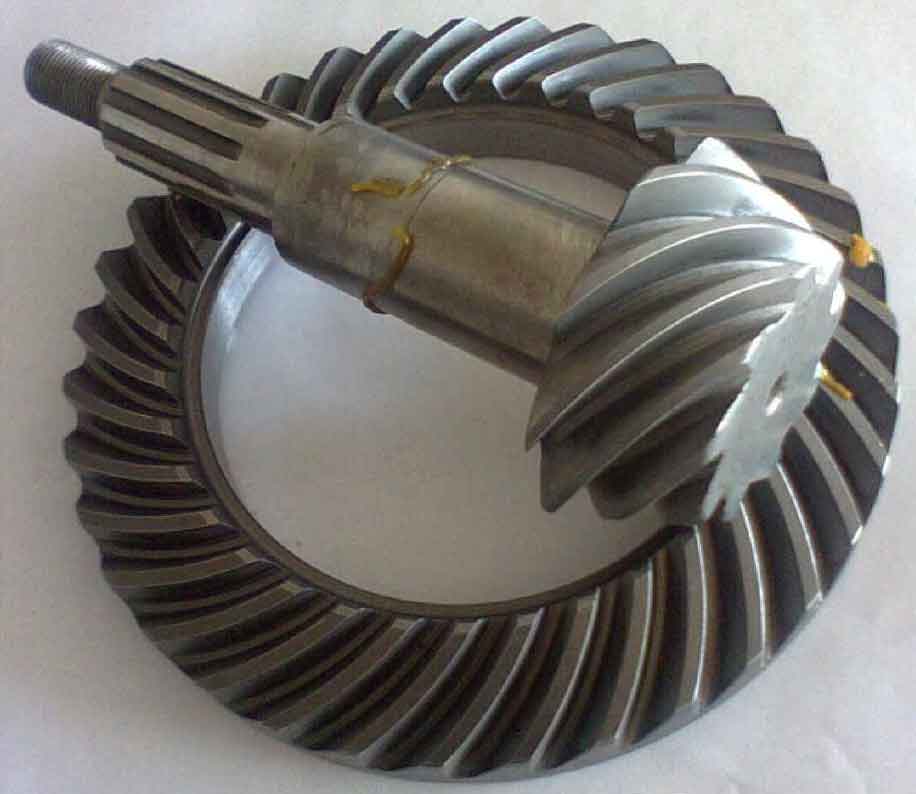Spiral bevel gears are a type of bevel gear used in various mechanical systems to transmit power and motion between intersecting shafts. Unlike straight bevel gears, which have teeth cut straight across the gear’s face, spiral bevel gears have teeth that are curved and form a spiral pattern around the gear. This spiral shape allows for smoother and quieter operation compared to straight bevel gears.

Design of Spiral Bevel Gears:
The design of spiral bevel gears involves several key parameters and considerations:
- Pitch Cone: Spiral bevel gears are based on the concept of pitch cones. The pitch cones are imaginary cones that are generated by the gear teeth. The intersecting axes of the gears are aligned with the apex of the cones.
- Cone Angles: The cone angles are the angles formed between the axis of the gear and the generatrix (the line traced by the tooth) of the pitch cone. These angles determine the size and shape of the gear teeth.
- Tooth Profile: The tooth profile of spiral bevel gears is complex due to the spiral nature of the teeth. The profile is typically generated using specialized cutting tools and machinery. The tooth profile must be precisely designed to ensure proper meshing and transmission of power.
- Tooth Geometry: Spiral bevel gears have curved teeth with a varying tooth thickness along the gear face. The geometry of the teeth, including the curvature, thickness, and pressure angle, is carefully calculated to optimize performance and minimize stress concentrations.
- Contact Pattern: Achieving proper contact between the gear teeth is crucial for efficient and reliable operation. The design of spiral bevel gears aims to achieve a well-distributed contact pattern along the tooth surface, ensuring load sharing and reducing wear.
Applications of Spiral Bevel Gears:
Spiral bevel gears find applications in a wide range of mechanical systems, including:
- Automotive Industry: They are commonly used in the differential mechanisms of automobiles to transfer power between the drive shaft and the wheels. They provide a compact and efficient solution for changing the direction of rotational motion.
- Industrial Machinery: Spiral bevel gears are utilized in various industrial machinery such as machine tools, printing presses, textile machinery, and packaging equipment. These gears are often employed in applications that require high torque and precision motion transmission.
- Aerospace and Defense: The aerospace and defense sectors utilize spiral bevel gears in helicopter transmissions, aircraft engines, and other critical systems. The gears are valued for their high load-carrying capacity and smooth operation.
- Power Tools: Many power tools, including drills, saws, and grinders, incorporate spiral bevel gears to transfer power efficiently from the motor to the cutting or grinding components.
- Marine Propulsion: Spiral bevel gears are used in marine propulsion systems to transfer power from the engine to the propeller shaft, enabling efficient movement of boats and ships.
Spiral bevel gears are a specialized type of bevel gear with curved teeth arranged in a spiral pattern. Their design involves considerations such as pitch cones, cone angles, tooth profile, tooth geometry, and contact patterns. They find applications in automotive, industrial machinery, aerospace, defense, power tools, and marine propulsion systems due to their efficiency, compactness, and reliability in transmitting power and motion between intersecting shafts.
